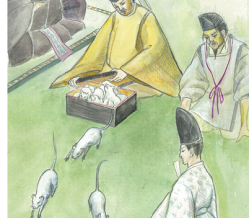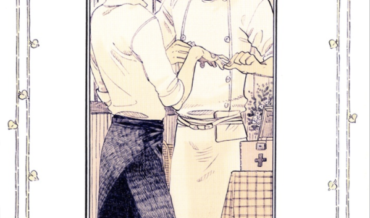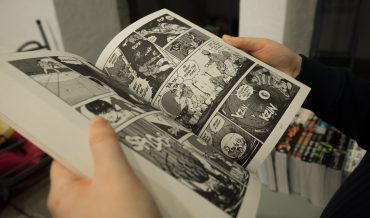Associate Professor, Department of English and Contemporary Society, Nagoya University of Foreign Studies
Encoding/decoding is a communication model that offers a theoretical approach to how messages in media, particularly mass media, are produced, disseminated, and understood. Popularized in the 1970s, it suggests that there are multiple ways for media users to interpret media texts. The ways in which media producers encode messages and users decode them are bound up here in a complex hierarchy of cultural specificity and power relations.
During the first half of the twentieth century a simple linear model of media communication was in vogue. Known as the “hypodermic” model, it was based on early observations of audience reactions to Western mass media and propaganda and argued that media had a direct influence on its audience and society: The media text contained a message that was “injected” into a passive audience, who received, understood, and were influenced by it in an unaltered form (Bineham 1988).
However, this became viewed as too simplistic, and its characterization of a passive, homogenous media audience as disempowering. In the 1960s, a number of semioticians,[1] most notably Roland Barthes and Umberto Eco, posited that audiences do not always receive the “preferred” message intended by the producers of the text (Murdoch 2016). Because people are not all the same but are shaped by various cultural factors, such as class, gender, race, nationality, and so on, the meanings they attach to the words, images, and sounds contained in a media text might be quite different to the meaning they were meant to receive. Semioticians called these “alternative” or “oppositional” readings.
Stuart Hall was a cultural theorist who was instrumental in founding the school of thought known as British Cultural Studies. He built on the ideas of scholars like Barthes and Eco, using television as an example of the complex process of meaning making in mass media. In a now famous paper, Encoding and Decoding in the Television Discourse (1973), Hall outlined the main features of the encoding/decoding model. Unlike the linear communications model, with its straightforward sender→message→receiver process, this model proposes that the process is more complex. It is made up of four connected practices:

*Reproduced from Hall (1999): 508.
These operate in a circuit, in which the media user is not entirely passive or powerless but whose interpretation and reproduction of a message can feed back into the production process (Hall 1999, 509) through social practices, thereby affecting future messages encoded in media.
The production stage of a text is where the preferred message is encoded by media producers and institutions. Consumption and reproduction are where it is decoded or interpreted by media users. The circuit does not always run smoothly, however, and the transmission of the preferred message can be interrupted. Such interruptions, argued Hall, are often due to the fact that, because of variations in race, gender, class, and so on, producers and audiences may not share the same “codes” of discourse; that is, they may attach different meanings or values to a sign or image (ibid., 510). David Morley’s (1980) well-known fieldwork on British television viewers attempted to show this through empirical research, mapping how viewers from different sociocultural groups—in this case class and gender—interpreted a popular current affairs program. He found that one’s background does have an impact on the meanings people create from media texts.
It is here that the concepts of cultural specificity, power, and ideology become crucial and highlight the insufficiency of the hypodermic model. The messages that are encoded in the production of mass media, according to the encoding/decoding model, are produced from a position of power; at the time this model was conceived, mass media was a key authoritative source of information. Further, the encoded messages tend to reflect the “dominant cultural order” of a society (Hall 1999, 513): classifications of a culture’s social and political world that are organized into an ideological hierarchy in which some discursive domains are more important or more legitimate than others. However, sometimes media users do not operate according to the dominant discursive codes; they attach different connotations to signs within the text, and this is where the smooth transmission of the message breaks down.
The encoding/decoding model used by Hall and Morley offers three ways in which audiences decode media texts. The first is the dominant-hegemonic position or preferred reading. Here, media users decode the text using and accepting the same dominant codes as its producers. They interpret it by attaching the same connotations to its signs and so receive the intended message “full and straight” (ibid., 515).
Second is the negotiated position. Here, the users are generally aware of the intended encoded message; they understand what is being signified and accord the dominant codes of discourse their privileged position at an abstract level. However, at the same time, they negotiate the message at a local level, accepting or rejecting parts of it based on their own cultural and social situation. They make exceptions to hegemonic connotations to better adapt the message to their own lived experience.
The final position is contested or oppositional. Here, users understand the intended message and are sometimes able to decode the signs according to the dominant connotations, but they reject these at both the abstract and local levels in favor of their own reading. Users “retotalize the message” (ibid., 517) using a different framework of reference that is in opposition to the one used when the text was encoded.
- Dominant/hegemonic
- Negotiated
- Contested/oppositional
These three positions acknowledge that media users are not a homogenous or passive group. The encoding/decoding model shows that it is possible for users to interpret media in multiple ways based on a variety of cultural factors and, in the reproduction stage of the cycle, to create their own messages and articulate their own readings of a text in a way that can feed back into the cycle. This can be seen in Japanese pop culture in the ways fans of Japanese male idol groups interpret and reproduce officially distributed media.
Japanese idols share some similarities with Western boy and girl bands: Usually put together by a management company, they perform highly manufactured pop music with dance routines. Like boy-band audiences in the West, the fan bases of male idols are overwhelmingly female. However, Japanese idol activity is spread across a wider spectrum; in addition to producing records and concerts, successful idols also act in stage plays, films, and television dramas, appear in commercials, variety shows, and several genres of magazine, and, in the case of popular group Arashi, even work as television news anchors.
Arashi is a male idol group that was formed in 1999 and is managed by the ubiquitous company Johnny and Associates (“Johnny’s”). Veterans in the idol scene, their faces are recognizable throughout Japan, even by people who do not identify as fans. Look up at a billboard, take the subway, leaf through a television guide at the convenience store—their media presence is unavoidable. Like most male idols, their domestic fan base is mainly female. They also have a large number of fans in East Asia and elsewhere.
Using the encoding/decoding model we can see that idol fans sometimes interpret and use media texts in a different way from what was intended. Official Arashi media (that is, media appearances approved by Johnny’s) attempts to create an everyday, or “boy next door,” image of the idols to encode a particular set of messages to its users about preferred masculinity and male sexuality in Japan: Namely, young men can play with nontraditional gender markers and male-male attraction but should ultimately be heterosexual, appeal to women, and, at the same time, maintain the strong homosocial bonds of a male-dominated society. However, some fans adapt or reject these messages when decoding official media to create their own alternative readings and texts. There is a group of female fans who interpret the relationships between Arashi members as sexual and create their own narratives of male-male sexuality that can challenge the dominant encoded position.
The ideals of desirable masculinity aimed at female Arashi fans through officially sanctioned media are not necessarily straightforward, and at times seem contradictory. They can be divided into the intersecting categories of masculinity, sex and romance, and sexual identity.
In terms of masculinity, Arashi’s media appearances support the long-standing Japanese hegemonic ideal of the salaryman; concurrently, they offer a “new” form of masculinity that may be more palatable to women and their increasing consumer power. The members are shown as hardworking young men who are part of a traditional, hierarchical Japanese company structure comprised of “senpai” (seniors) and “kōhai” (juniors). This is highlighted in the variety show Arashi ni Shiyagare (NTV), where the members learn new skills from older male guests. On the other hand, Johnny’s idols offer an alternative to the old salaryman ideal: Their media performances depict them as emotionally sensitive, domestic, youthful, and fashionable though imperfect. They are often described as “kawaii,” a highly marketable (though complex) form of cuteness. These are unthreatening traits that are said to appeal to female consumers and are becoming widespread in Japanese entertainment and media, to the extent that they may be co-opted as part of the dominant form of masculinity (Glasspool 2012).
The band members’ sexual and romantic depictions tread a careful line between being attractive or erotic and remaining “pure.” They are all fashionably groomed and attired, occasionally making a deliberate erotic display of their bodies for their fans, for example member Sakurai Shō’s almost-nude photoshoot in the women’s magazine An-An (January 2010). Arashi frequently discuss romance in song lyrics, magazines, and on television, but always in nonspecific terms. This is because Japanese idols must appear to be unattached. The discovery that a male idol has a girlfriend is enough to damage their career, as part of their boy-next-door role is to appear close and symbolically available to their fans (Karniol 2001, 62). They should seem romantic in nature but not sexually active, thus maintaining a “pure” surface.
Regarding sexual identity, Arashi’s media contains both validation of dominant heteronormativity and the suggestion of romantic attraction within the band. The members talk about their ideal girlfriends in interviews and often play heterosexual characters in dramas. Occasionally, though, they display physical affection (“skinship”) that could be interpreted as more than friendly or talk about each other in seemingly romantic terms. Members Ōno Satoshi and Ninomiya Kazunari are particularly well-known among fans for this, exchanging romantic declarations, such as this quote from Ōno in the idol magazine Wink Up (June 2008): “That hot kiss we shared [. . .] No other lips can compare to yours.” Ninomiya hugs, kisses, and gropes Ōno onstage and on television. This appearance of playful same-sex attraction among idols could be considered a way of drawing attention away from other “scandals,” which can be devastating to an idol’s career; for example, when Nimomiya was rumored to be dating a female costar, thereby breaking the unspoken rule that idols remain single. Playing up romantic attraction between band members can help shift focus at such times (Glasspool 2012).
Looking at these depictions, we might assume that Arashi’s fan base is being offered a variety of legitimate positions on gender and sexuality, both dominant and alternative; suggesting that the producers of male idol media are encoding an encouragingly progressive message for idol fans amid Japan’s relatively conservative mainstream media. However, it is important to remember the way in which mass media tends to prioritize dominant discursive codes (Hall 1999), generally leaning toward the status quo. Although Arashi’s performances appear to provide a number of masculine or sexual ideals, the instances upholding male-dominated heteronormativity far outweigh those that question these norms; this makes it clear that official idol media are not intended to really challenge established gender or sexual hierarchies.
Some Arashi fans accept the preferred reading, while others do not read the idols’ performances according to the dominant codes. Fan commentary and media show the variety of positions they take toward the encoded messages. Many, even the majority, of fans do adopt the dominant-hegemonic position when decoding Arashi media. Fans most often reproduce the “new” model of stylish, emotionally available masculinity, frequently couching their discussion of the members in terms of their looks and “kawaii” attributes, although their hard work and dedication is also praised. Among themselves, and in online forums, fans also discuss the members’ ideal girlfriends and speculate about who they may be dating. None of this deviates from the socially acceptable model of heteronormative masculinity sold by Johnny’s.
However, a not-insignificant number of fans adopt negotiated or contested positions when it comes to sexuality. While accepting the dominant position on “cute” masculinity, they decode the skinship and affection between Arashi members as romantic or sexual rather than friendly. It is true that Arashi media occasionally appears to deliberately encode male-male romance as a way of attracting fans or as a distraction from scandal, but as discussed above, this is limited to a very small percentage of official media. Some fans choose to focus on these and use them as a premise for reading all affectionate interactions between the members as homoerotic. They reproduce their version of the decoded message in online discussion spaces and in amateur comics known as dōjinshi, which are disseminated at special conventions like Comic Market, in some physical stores, and online.
Female-created texts involving homoeroticism form a popular genre in Japan known as Boys’ Love (BL). In BL dōjinshi created by Arashi fans, members are paired together and depicted in romantic or sexual situations. This form of fan reproduction could be considered an oppositional reading of the encoded position. BL Arashi fans exclude depictions and discussions of heterosexuality; it is almost impossible to find an Arashi dōjinshi with a male-female central couple, and in the BL texts, women are virtually absent even as peripheral characters. It could be said that these fans are rejecting the dominant encoded message and creating one that challenges heteronormativity.
On the other hand, there have been many theorizations as to why women use BL texts. Some motivations are put down to dissatisfaction with the status quo, wishing to depict a relationship free from the implicit power dynamics of heterosexuality or a controlling male gaze (Buckley 1991). Others, however, do not stray so far from hegemonic norms: taking pleasure in a sexual situation without fear of consequence (Mori 2010) or simply the aesthetic attraction of looking at beautiful men (Lunsing 2001). Among Arashi fans, all of these and more may be present. Neither do these fans tend to set up scenarios in which the members are explicitly gay: they do not engage with LGBTQ politics (Hori 2013). Instead, their decoded messages show male sexuality as being nebulous and not necessarily connected to everyday life; they do not actually deny the primacy of heterosexuality.
In this sense, then, it might be more accurate to say that BL Arashi fans take a negotiated rather than an oppositional position regarding male sexuality: They are aware of the dominant discursive codes and do not explicitly contest them, but they decode them in a different way to create their own preferred meanings that offer an alternative to the hegemonic norm.
The encoding/decoding model is not perfect. It has been critiqued for its applicability to fictional texts and the difficulty of defining the preferred reading. Morley pointed out that it required some refinement, because the original model does not make enough of a distinction between the processes of users agreeing/disagreeing with the preferred reading and simply understanding/not understanding it (2013, 18). Sven Ross (2011) addresses some of these concerns in an updated model of the three types of reading. What encoding/decoding does allow us to do is envisage the possibility of active audiences and of multiple meanings being drawn from one media text. In the case of Arashi fans, some take a negotiated position on representations of male sexuality in official media. Even if the encoded message supports heteronormativity, such fans use it to create narratives that offer an alternative to hegemonic constructions of sexuality, thereby creating for themselves a variety of pleasurable and potentially subversive reproductions that can be fed back into mainstream media.
Notes
- Semiotics is the study of signs, symbols, and their use. ↑
References
Bineham, Jeffery L. 1988. “A Historical Account of the Hypodermic Model in Mass Communication.” Communication Monographs 55, no. 3: 230–46. https://doi.org/10.1080/03637758809376169.
Buckley, Sandra. 1991. “‘Penguin in Bondage’: A Graphic Tale of Japanese Comic Books.” In Technoculture, edited by Constance Penley and Andrew Ross, 163–95. Minneapolis: University of Minnesota Press.
Glasspool, Lucy. 2012. “From Boys Next Door to Boys’ Love: Gender Performance in Japanese Male Idol Culture.” In Idols and Celebrity in Japanese Media Culture, edited by Patrick W. Galbraith and Jason G. Karlin, 113–30. New York: Palgrave MacMillan.
Hall, Stuart. 1973. “Encoding and Decoding in the Television Discourse.” Paper for the Council of Europe Colloquy on “Training in the Critical Reading of Televisual Language,” Organized by the Council and the Centre for Mass Communication Research, University of Leicester, September 1973. Birmingham: Centre for Contemporary Cultural Studies, University of Birmingham. https://www.birmingham.ac.uk/Documents/college-artslaw/history/cccs/stencilled-occasional-papers/1to8and11to24and38to48/SOP07.pdf
Hall, Stuart. 1999. “Encoding, Decoding.” In The Cultural Studies Reader, edited by Simon During, 507–17. 2nd ed. London: Routledge.
Hori, Akiko. 2013. “On the Response (or Lack thereof) of Japanese Fans to Criticism That yaoi is Antigay Discrimination.” Transformative Works and Cultures 12. https://doi.org/10.3983/twc.2013.0463.
Karniol, Rachel. 2001. “Adolescent Females’ Idolization of Male Media Stars as a Transition into Sexuality.” Sex Roles 44, no. 1/2: 61–77.
Lunsing, Wim. 2001. Beyond Common Sense: Sexuality and Gender in Contemporary Japan. London: Kegan Paul Limited.
Mori Naoko. 2010. Onna wa Poruno o Yomu: Josei no Seiyoku to Feminizumu. Tokyo: Seikyūsha.
Morley, David. 1980. The ‘Nationwide’ Audience. London: BFI.
Morley, David. 2013. “Changing Paradigms in Audience Studies.” In Remote Control: Televisions, Audiences, and Cultural Power, edited by Ellen Seiter, Hans Borchers, Gabriela Kreutzner, and Eva-Maria Warth, 16–43. Oxon: Routledge.
Murdoch, Graham. 2016. “Encoding and Decoding.” In The International Encyclopedia of Media Effects, edited by Patrick Rössler, Cynthia A. Hoffner, and Liesbet van Zoonen, 1–11. New Jersey: John Wiley and Sons, Inc.
Sven, Ross. “The Encoding/Decoding Model Revisited.” Proceedings of International Communication Association Conference, Boston. May 26–30, 2011. http://urn.kb.se/resolve?urn=urn:nbn:se:su:diva-71460.




